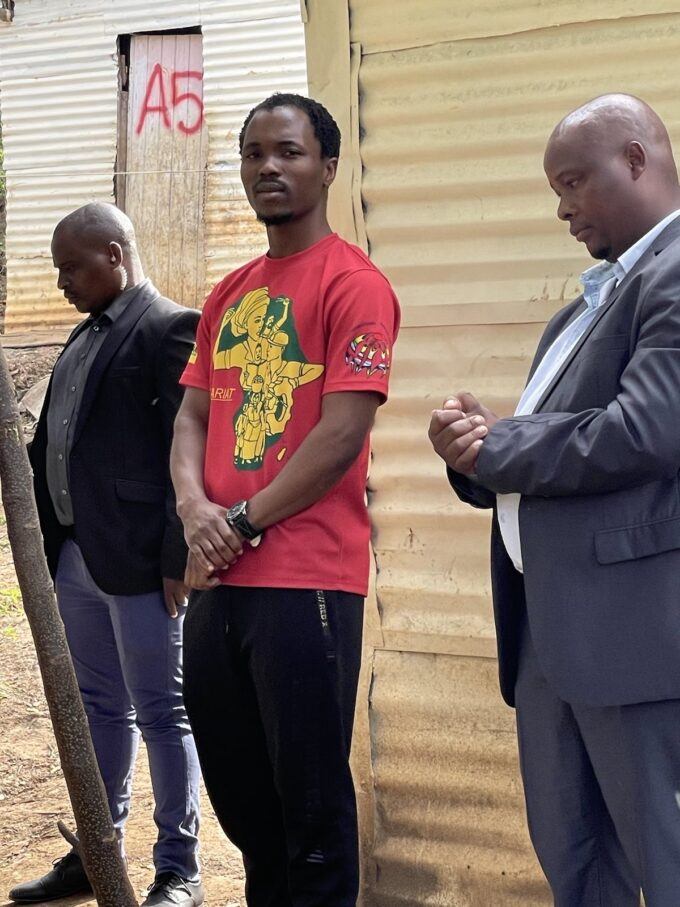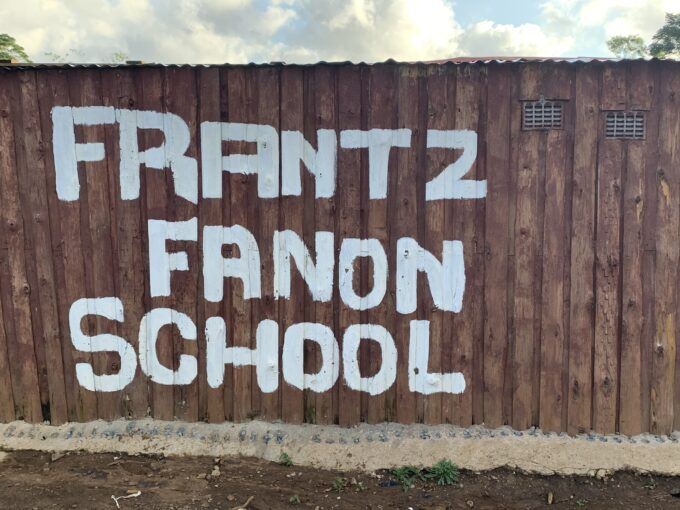
Lindokuhle Mnguni speaking outside the home of Nokuthula Mabaso on the morning after she was assassinated, 6 May 2022. Photo: Richard Pithouse.
Last week the tenth anniversary of the massacre of striking miners at Marikana was marked in South Africa. The televised state murder became one of the ruptures in the flow of time that generates a before and after in national consciousness. It took its place with the massacres by the apartheid state in Soweto in 1976 and Sharpeville in 1960.
Of course, national consciousness is fractured by class, among other things. The insurgent strike at Marikana, and its repression, swiftly sparked a self-organized farm workers’ strike in the orchards and vineyards in the Western Cape, and a series of urban land occupations across the country named Marikana. Naming occupations in this oppositional way was a clear shift from the years when they were often given names that were politically neutral, or indicative of a direct affiliation to elite nationalism. In these new counter-publics the sense that affirming the value of the life of the oppressed would inevitably run the risk of death became common.
Massacres also mark breaks in international consciousness. “The murders of Sharpeville”, Frantz Fanon wrote in 1961, “shook public opinion for months. In the newspapers, over the wavelengths, and in private conversations Sharpeville has become a symbol. It was through Sharpeville that men and women first became acquainted with the problem of apartheid in South Africa”. The repression of the Soweto Uprising was an even greater shock to international complacency. The massacre at Marikana largely put an end to the remaining confidence in the ANC on the international left making it easier for autonomous organizations to build solidarity across borders.
The slow Marikana
When the striking miners were massacred at Marikana the post-apartheid state had been killing unarmed protestors at an escalating rate since 2000, and while most political assassinations were consequent to intra-ANC contestation there had been some assassinations of independent activists. These kinds of killings had often been understood as aberrations, as hangovers from the pre-democratic past, hangovers that would resolve in time as liberal democracy became more fully hegemonic. After Marikana it was no longer widely assumed that time was on the side of justice. The idea that what some in the NGO world had affirmed as a ‘politics of patience’ would be redeemed with the passage of time was put to rest.
In fact, things were plainly getting worse for the oppressed in terms of both material and political realities. By 2013 assassinations of independent activists were becoming regular. Abahlali baseMjondolo, a movement primarily anchored in urban shanty towns and by far the biggest and best organized popular movement to have emerged after apartheid, was hit particularly hard. It began to talk about the ‘politics of blood’ and an ongoing ‘slow Marikana’.
The politics of Abahlali baseMjondolo came to be saturated with an awareness of death, something that has deepened as the years have passed. In meetings it is common to hear women – often mothers trying to find a space in the world for their children – say, with measured determination, umhlaba noma ukufa (land or death). Several land occupations and branches in the movement are named for the dead. Their names are recited in poems and in the songs composed by a profusion of choirs, their stories performed in community theatre.
Political violence, once concentrated in the city of Durban and its hinterlands, is increasingly a national phenomenon. In parts of the country honest civil servants and trade unionists organizing outside of the established fiefdoms are now also at risk of assassination.
Political or politically inflected violence is not only carried about by the state and more shadowy professional assassins – the izinkabi (oxen) – usually linked to elements in the ANC. In July last year riots, largely concentrated in Durban and surrounding areas, took 354 lives. In May 2008 longstanding state and popular hostility to African and Asian migrants metastasized into a pogrom, taking 62 lives. Xenophobic violence, ebbing and flowing in intensity, is now a permanent backdrop to ordinary life which is itself intimately wound into violence.
The intersection of an accumulation of historical trauma into the present, a desperate economic crisis for the majority and state contempt for impoverished people has created a grimly violent society.
The police in South Africa kill unarmed Black people at a far higher rate than the police in the United States. The country, trailing a few others in central America and the Caribbean, has the tenth highest murder rate on the planet. Rates of sexual violence and violence against women are equally horrific. There are regular deaths from state neglect, including fire and floods in the shanty towns. Health care is in crisis, with hospital budgets being brazenly looted. A project begun in 2016 to move patients out of state-run psychiatric facilities and into cheaper forms of ‘community care’ resulted in 144 deaths, many from starvation and neglect.
Unsurprisingly the most effective and sustained forms of political organization among the oppressed are rooted in humanistic commitments, on an insistence on the non-negotiable value of each human life. This is the pivot from which dissent is leveraged and people confront the risk of violent death to affirm the value of life.

Frantz Fanon School, eKhenana Commune, Durban, South Africa. Photo: Richard Pithouse.
Building a Commune
In recent years the eKhenana (Canaan) Commune in Cato Manor, a particularly violent part of Durban, has become an important node in the slowly developing infrastructure of grassroots militancy. Initially a fairly standard land occupation it began, after confronting serious internal and external challenges, including relentless state violence and hostility from the local ANC, to develop into a working commune. It was run on a directly democratic basis and worked to build collective projects of various kinds including a large vegetable garden, a poultry project, a creche, a shared kitchen, a co-operatively run store, theater work, a poetry project and, impressively, a political school – the Frantz Fanon School.
The food sovereignty project carries the name of Nkululeko Gwala, who, in 2013, was the first leader of the movement to be assassinated. The community hall is named in honor of Thuli Ndlovu, a leader of the movement who was assassinated in 2014. The poultry project is named after Sifiso Ngcobo, also a leader in the movement, who was assassinated in 2018. These projects were, and still are, an affirmation of the value of the lives of those who are most dishonored in a brutal society, an affirmation saturated with an awareness that, along with modest material gains such as scraps of land, the price for an organized defense of the humanity of the oppressed is frequently paid in blood. It is often said, with a mixture of resolution and resignation that “Siyolifela eKhenana” (We will die in Canaan).
This is an intensely local struggle for the use and management of a small piece of land. But it has had much wider resonance. The seeds used to begin the garden were a gift from the Movimento dos Trabalhadores Rurais Sem Terra (MST) in Brazil, and the idea for the political school was inspired in significant part by the MST’s Florestan Fernandes National School in Guararema, near Sao Paulo. Activists from across the country, on occasion from elsewhere in southern Africa, and at times from even further away, from countries like Brazil, Jamaica and the United States, have participated in the Frantz Fanon School. The large meetings at the Commune begin with the Internationale. Radical humanism, expressed in an African register, easily moves into an identification with the essential communist idea.
The axe of repression has fallen hard this year. Ayanda Ngila a young leader in the Commune was assassinated by thugs linked to the local ANC on 8 March, in the middle of the afternoon. The next to fall was Nokuthula Mabaso. Her life was taken, in front of her children, as she was cooking the evening meal on 5 May. Lindokuhle Mnguni, the chairperson of the Commune’s council, was murdered in the early hours of the morning on Saturday, 20 August. He was twenty-eight years old.
All three had played leading roles in building, sustaining, and defending the Commune. Ngila and Mnguni had spent two periods in the notorious Westville Prison after twice being arrested on bogus charges and denied bail. The first stretch was for 6 months. Mnguni, known for his humor and kindness, had an intense interest in ideas and a calm, soft-spoken charisma. He was remarkably self-possessed for such a young man.
He had been interested in radical ideas since high school, and in particular Steve Biko, Frantz Fanon and Karl Marx. The reading group that he ran in prison also included Paulo Freire, a thinker whose ideas have had constant traction in union and movement spaces in Durban since Biko first introduced them in the early 1970s. Mnguni was uncompromisingly anti-patriarchal, identified as Marxist and a Pan-Africanist and worked closely with the movement against the monarchy in Swaziland. His comrades all saw him as a future leader of the movement, if not some sort of bigger project, a project with the potential to acquire significant historical weight.

Lindokuhle Mnguni speaking at the eKhenana Commune, Durban, at the memorial for Nokuthula Mabaso, 12 May 2022. Photo: Siya Mbhele.
Speaking at a public event in Johannesburg in June, Mnguni, reflecting on discussions with his comrades in prison, said that:
They will know that their strategy to keep us behind bars is not working and the only choice they will be left with is to kill us but we won’t stop. We used to counsel each other several times – because with the assassination of Comrade Ayanda, I was deeply hurt but at the same time I managed to survive because of the things that we discussed before – We used to talk a lot about death because we knew that someday luck won’t be on our side. They will kill us. We even said, ‘it is socialism or death!’ because we want it. No matter what it takes, even if it means death because we can’t continue living in these inhumane conditions.
Now another body is in the mortuary, and no one can sleep. Another memorial will be held in the Commune, another political funeral in a rural home. Another coffin will be draped in the red banner of the movement. Another name will be inscribed in songs, poems, theater and slogans, and onto the movement’s red t-shirts.
Mnguni, along with Ngila and Mabaso, now takes his place with Berta Cáceres, Marielle Franco, Gauri Lankesh, Patricia Rivera Reyes and so many others in so many places.
Three lines from Philip Rexroth come to mind: “The murderers are at work / They are stoning Stephen / They are casting him forth from every city in the world.”
In South Africa the politics of death stalks every attempt to affirm a politics of life in the detritus of a revolution co-opted from within and without, and now mutated into a predatory excrescence on society. It is an unbearably violent society, a society grounded in contempt for most of its people, a society that turns people into waste and often kills them when they affirm the personhood of the oppressed.
Nonetheless, the struggle continues. On Saturday afternoon, the day of the assassination, the movement’s Deputy President Mqapheli Bonono was in the decaying mining town of Kimberly in the Northern Cape to address a group of shop stewards on the need to unite union and community struggles. It’s President S’bu Zikode was in Thembisa, a large township outside Johannesburg, to launch a new branch. After the launch he told a journalist “Our democracy is coming to its end where there will be nobody left to speak [about how] the lives of people count for nothing.”